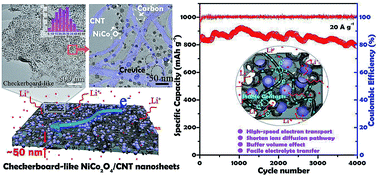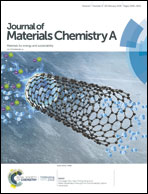High-loading individually dispersed NiCo2O4 anchoring on checkerboard-like C/CNT nanosheets as a binder-free high rate electrode for lithium storage†
Abstract
Nanoscale transitional metal oxides (TMOs) are promising anode materials for high-performance lithium-ion batteries (LIBs), but achieving a high-load TMO electrode with excellent conductivity and good cycling stability still remains a big challenge especially for nanosized TMO particles. Herein, we report a novel strategy to prepare checkerboard-like NiCo2O4@C/CNT (N@C/CNT) nanosheets by a facile cellulose template-assisted method. The 2D, 1D and 0D ternary hybrid structures achieve individual dispersion of high-load NiCo2O4 nanoparticle (NP) “chess pieces” (diameter ∼ 25 nm) anchored on C/CNT nanosheets (thickness ∼ 50 nm), in which the CNT “grid lines” and cellulose-derived carbon “chess lattices” act as a high-speed conductive network and loading substrate, respectively. Due to the self-assembly of these nanosheets, the designed electrodes are created with no binder or other additives and possess adjustable thickness, high electrode density and a strong conductivity of 175.9 S cm−1 even at a high NiCo2O4 content of 85.1%. The binder-free electrode exhibits superior rate capabilities (1208 mA h g−1 at 0.1 A g−1 and 830 mA h g−1 at 20 A g−1) and little capacity fading at 20 A g−1 over 4000 cycles. Such a strategy enables an ultrahigh mass loading of 12.8 mg cm−2 (2.5 g cm−3) with the same time high electrochemical performances.



 Please wait while we load your content...
Please wait while we load your content...